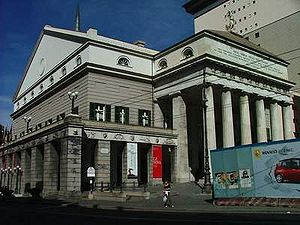Carlo Felice Theater
The Teatro Carlo Felice is the main opera house in the Italian city of Genoa . The house is known at national level and, with its program, which includes operas , ballets , symphonies , but also lectures and other events, is one of the best in Italy.
The theater is located in the central Piazza De Ferrari , and thus in the center of the city itself. In front of the pillars of the main entrance is the equestrian monument of the Italian general and national hero Giuseppe Garibaldi .
General manager of the house is Gennaro Di Benedetto.
history
On December 24, 1824 it was decided to build an opera house in Genoa and name it after Duke Carlo Felice . On January 31, 1825, the Genoese architect Carlo Barabino submitted his project for the opera house. The foundation stone was laid on March 19, 1826 on the bottom of the demolished Dominican church of San Domenico .
With Vincenzo Bellini's opera Bianca e Fernando , the opening of the opera house was celebrated on April 7, 1828, although work on the structure and decoration had not yet been completed at the time. The auditorium with its five tiers, each with 33 boxes, a gallery and a standing area in the orchestra pit , offered space for 2,500 guests. The acoustics of the room were considered to be some of the best of the time. On May 30, 1865, the opera Amleto by Arrigo Boito (libretto) and Franco Faccio (composition) was premiered at this house , with great success. However, this opera was subsequently forgotten and only performed again in the United States in 2014.
In 1892 was the occasion of the Columbus celebrations of the four hundredth anniversary of the discovery of America , the Teatro Carlo Felice renovated and redecorated. Giuseppe Verdi was asked to compose an opera for the occasion. Although he had spent almost 40 years in Genoa every winter since 1853, his ties to the opera house were rather low. Therefore, referring to his old age, he declined the offer and instead suggested having the festival opera composed by Alberto Franchetti , who presented his second world success with Cristoforo Colombo .
The hall was rebuilt several times between 1859 and 1934, but retained its character until February 9, 1941, when a shell from a British warship hit the roof of the auditorium, destroying the valuable Rococo roof liner. The largest work of art in the ceiling decoration from the 19th century was a wide angel circle with cherubins and other angelic beings painted in light high relief .
Further damage was caused on August 5, 1943 by fire bombs on the side stages and the fundus . A large part of the metal structure of the damaged rear building was stolen during subsequent looting. In September 1944, the front of the opera house was finally destroyed in air raids. What remained were the roofless side walls with the hallways. After the destruction, performances were temporarily held in the now-closed Cinema Teatro Margherita.
After the end of the war, the reconstruction of the opera house began. The first project by Paolo Antonio Chessa was rejected in 1951; Carlo Scarpa's proposal for a project was accepted in 1977, but its implementation was prevented by the architect's untimely death. The house owes its present appearance to Aldo Rossi , who restored the historical facade, but completely modernized the interior. The Teatro Carlo Felice was reopened in June 1991 with Verdi's Il trovatore and today has a main hall with 2,000 seats and a smaller auditorium that seats 200.
literature
- Spike Hughes : Great Opera Houses. A Traveller's Guide to their History and Traditions. Weidenfeld and Nicolson, London 1956.
Web links
- official homepage (Italian)
Coordinates: 44 ° 24 ′ 29.1 ″ N , 8 ° 56 ′ 5.2 ″ E

